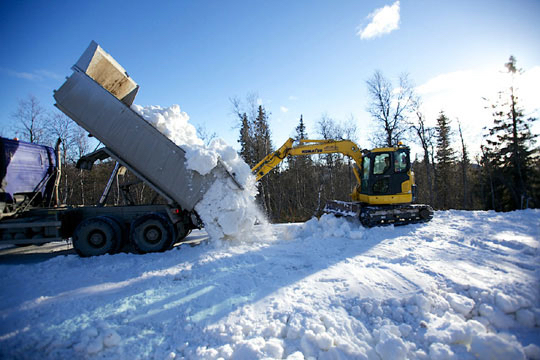
A lot of places have snow in the middle of the winter, but destinations that can offer reliable and consistent snow at the beginning of the season have a leg up in the battle for the skiers.
The first snow in the fall is magical for skiers, and many are willing to travel quite far to get on snow. Accordingly, guaranteeing early skiing conditions has become big business for the ski resorts, and they no longer trust the weather gods to provide the white gold on schedule.
Norway’s destinations of Beitostølen, Sjusjøen and Trysil are known for early season skiing, and the past few years the resorts have been competing to be the first to offer cross-country skiing in the fall, investing large amounts of money and resources in their early season packages.
Trysil, a ski destination in eastern Norway known for early snow and stable winters, already expanded its season this year with a guaranteed opening date of Oct. 29. After calculating that they will need 12,000 cubic meters of snow to pack and groom 6 kilometers of snow 5 meters wide and 0.35 meters deep, the resort stored 25,000 cubic meters of snow since late March.
Significant investment
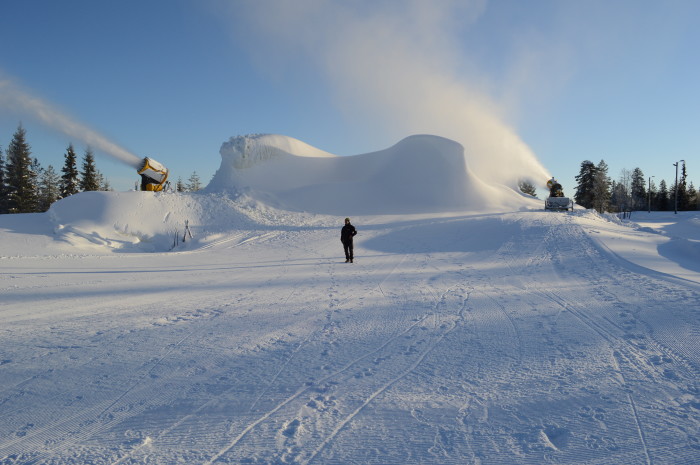
For Trysil, this marks the first year the venue is offering early skiing on old snow. Over the past couple of years, the snow manufacturing division in Trysil has invested about a million dollars in water pipes and snow guns, and cleared a site for storing snow over the summer, where the mound has been kept since March.
The mound of snow was covered with 30 centimeters (about a foot) of sawdust, bark and cellulose chips to prevent melting over the summer, and presently, the snow is being transported back onto the trails.
It takes two excavators and two days just to uncover the mound. Then, several trucks transport the snow onto the tracks, along with the excavators, before the groomers will pack and track the courses.
The whole process takes about 10 days, and started on Oct. 20 for an as-scheduled Oct. 29 opening.
Science
Storing snow over the summer takes more than just piling up a bunch of snow and covering a mound. To prevent as much runoff as possible, the snow must located out of direct sunlight and covered with substance that won’t attract heat and turn the snow to ice.
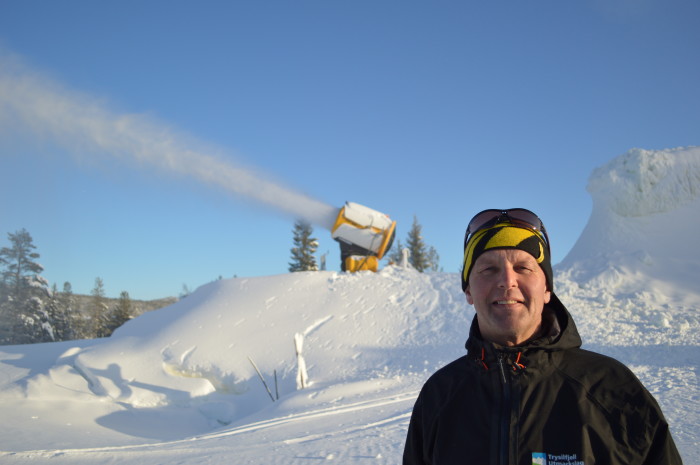
Furthermore, developing an ample snow depot is a project that takes years to cultivate. The first year, there will be a bigger runoff, but as the depot is used year after year, the ground will develop permafrost where the mound sits. Accordingly, the runoff is significantly reduced after the first couple of seasons, explained Ola Gerhard Sørhuus, who is in charge of the summer snow project in Trysil.
But how does it feel to ski on last season’s snow? “It will be somewhat more compact than fresh falling powder, more like spring skiing,” Sørhuus said on the Trysil website.
In its first season, Trysil reports having more than 7,000 skier-days booked for the early snow. Skiers pay 50 kroner or roughly $6 U.S. dollars per day in trail fees, which also includes access to the service building with bathrooms and showers. Additionally, teams and training groups that sign up for the early skiing in Trysil get their own wax cabin at stadium by the trailhead.
Popular strategy
Beitostølen has been storing snow from the previous season for several years now, and opened its World Cup trails at the ski stadium as planned on Oct. 30. The venue planned to groom its higher-elevation trails as well if there was sufficient snow, but this year there is currently no natural snow up high.
Furthermore, warm weather on the opening weekend and through the first part of this week has created a headache for Beito, which is scheduled to host the national International Ski Federation (FIS) season-opening races Nov. 13-15. The snow is melting rapidly, and it is too warm to make additional snow with traditional snowmaking equipment. According to NRK, there is no solid plan B, but organizers are trying to cover the snow and restrict use until temperatures drop below freezing.
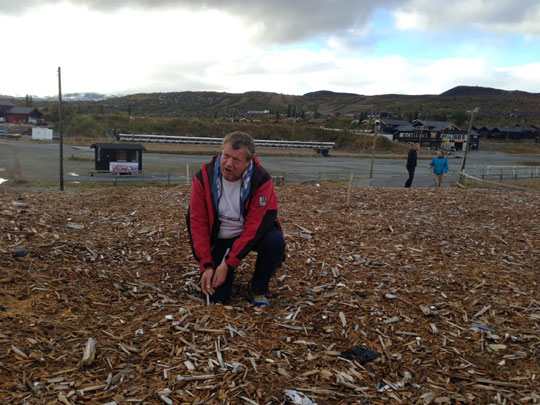
“It looks unfortunately, not as bright,” Beitostølen event coordinator Erik Østli told NRK, according to a translation. Temperatures reached 9 degrees Celsius (48 degrees Fahrenheit) on Monday night. “It’s like a hairdryer, and very bad news for the trails.”
In a phone interview with FasterSkier last month, Østli emphasized that offering early skiing on last season’s snow was worth the effort, even though he doesn’t anticipate making a profit on the old snow. However, putting Beitostølen on the map as a guaranteed destination for early skiing is valuable in itself, Østli said.
While cross-country skiing in Norway generally is free, even on groomed trails and on private property such as ski resorts, the areas offering early skiing tend to charge a trail fee.
“We have to charge a small fee for the early season skiing,” Østli explained. “The labor and materials involved in storing the snow over the summer, insulating the snow with saw dust to reduce melting, then uncovering the mounds in the fall, moving the snow back to the trails and grooming the stadium is expensive.”
The daily trail fee most places is 50 kroner, or roughly $6 dollars, for 5 kilometers of World Cup standard trails at the Beitostølen stadium. To break even on the early snow, Beitostølen would need 20,000 skiers to come through the stadium before December, when the fee is lifted, and although the early skiing is popular, Østli didn’t expect the proceeds to reach that mark.
Manmade snow
Snow guns are hardly a new invention, but last fall, Sjusjøen’s World Cup venue, Natrudstilen by Lillehammer, invested almost $1 million dollars in a set of snow guns capable of producing snow at temperatures well above 20 degrees Celsius (about 75 degrees Fahrenheit).
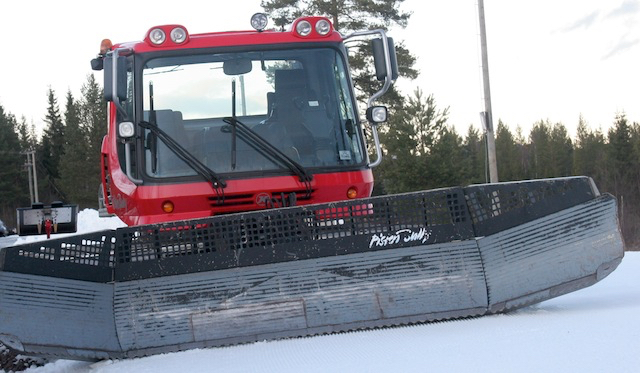
However, the higher the temperature, the lower the production capacity. At 15 degrees Celsius (59 Fahrenheit), the guns can make 250 cubic meters of snow per day, which means it will take 15 days to cover 3 kilometers of trails at Natrudstilen, trail manager Johannes Haukåssveen told NRK.
Natrudstilen has put the guns to work, and opened its World Cup courses and the biathlon stadium on Sept. 25.
The entire World Cup venue at Natrudstilen now has a solid foundation of manmade snow that will be able to handle a lot of traffic until natural snow accumulates and the skiers have more options to choose from.
Other resorts and trail systems will also start using conventional snow guns as soon as the temperatures drop and the humidity level allows.
Next year, Geilo, Norway, will also store snow to kick off the nordic season in late October. The resort currently offers early skiing for alpine starting in late September and uses the same kind of snow guns that Natrudstilen has.
Inge Scheve
Inge is FasterSkier's international reporter, born and bred in Norway. A cross-country ski racer and mountain runner, she also dabbles on two wheels in the offseason. If it's steep and long, she loves it. Follow her on Twitter: @IngeScheve.



